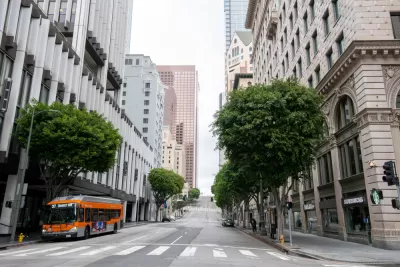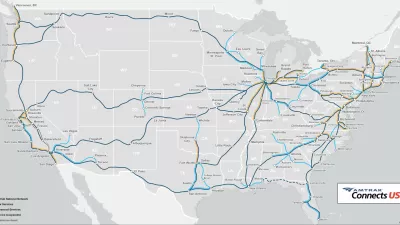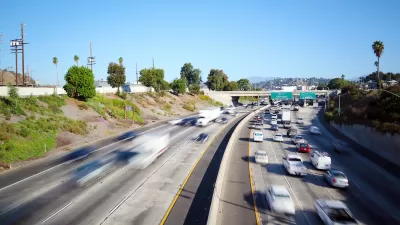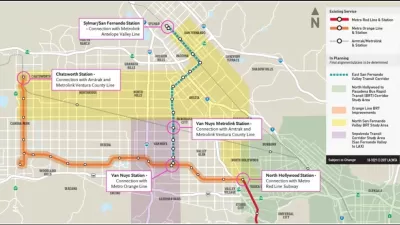The pandemic has forced difficult confrontations with inequities that existed long before the novel coronavirus. L.A. Metro planners are responding by charting a path toward a transportation system that reverses and improves those previous realities.

Plans for post-pandemic recovery are taking shape at the Los Angeles County Metropolitan Transportation Authority (Metro).
Early in the pandemic, Metro CEO Phil Washington appointed a Recovery Task Force comprised of Metro staff members to chart a path to recovery that accomplishes more than getting riders back onto transit and balancing the budget. This recovery plan is intended to build a more effective, equitable, and sustainable transportation system than the one that served the county before the arrival of the coronavirus.
The Task Force released three reports during the spring and summer, with 20 recommendations that are already in various stages of implementation. On Monday, the Task Force released a 106-page draft of its final report [pdf], which includes 17 new recommendations. The Task Force is seeking public input on the draft final report through January 8, 2021.
Metro Chief Innovation Officer Joshua Schank told Planetizen this week that the Task Force recognizes the pandemic as a chance to reset the goals of transportation planning in the nation's most populous county toward more equitable, environmentally-friendly outcomes, and to accelerate the implementation of Metro's Vision 2028 Plan.
The Metro Recovery Task Force mimics the approach of President-elect Joe Biden's campaign, seeking to "build back better" than before. In Metro's case that means reversing the inequities of the pre-pandemic transportation system and acknowledging the disparate effects of the pandemic on low-income residents, people of color, and women. To address transportation inequities in Los Angeles County, the Task Force also had to consider, among other factors, the safety of employees and riders and the constraints of a sudden and a "seismic" loss of revenue.
Swimming Against the Stream of Automobile Dependence
Nine months into the pandemic, Los Angeles County seems poised to produce more congestion and pollution due to a large-scale shift away from urban neighborhoods and alternative modes of transportation, though that potential has been delayed during the pandemic by high unemployment rates and increased telecommuting.
Riders began abandoning U.S. transit systems to avoid potential infection in the first days of the pandemic (though most of those concerns proved unfounded in the ensuing months). Metro's ridership numbers still hover around 50 percent of pre-pandemic forecasts, and deep budget cuts have already left a mark on the system.
Add to that morass of challenges an ongoing fiscal crisis, as Congress failed to move forward on an economic stimulus package until very recently—even then planning to spend far less than would be necessary to provide long-term financial security for transit agencies.
A return to a more car-centric normal would not be desirable for anyone living in L.A. County, but it’s an especially grim prospect for low-income individuals. A growing body of research shows that automobile dependency entrenches social and economic inequalities, for example. Alternatively, access to non-automotive modes of transportation can reduce costs and enable social and economic mobility.
Several signs of increasing automobile dependency are already visible. Data from the Southern California Association of Governments cited by the Task Force reports that automobile travel, as measured by Vehicles Miles Traveled, is recovering faster than transit ridership in the region. Reports from around the country show automobile purchases climbing, even in famously transit-centric New York City, and the real estate markets in car-centric suburban and rural locations are booming, locking automobile dependency into whatever post-pandemic recovery eventually takes shape.
One of the 17 recommendations included in the Task Force's draft final report identifies the need to reduce reliance on single-occupant automobiles by providing incentives for alternative modes of transportation.
Metro already has some of the funding tools and partners in the private sector and academia to achieve this goal. Using $1.3 million in funding from the Federal Transit Administration's Accelerating Innovative Mobility program, Metro is partnering with the Harvard School of Business, the Duke Center for Advanced Hindsight, and private sector technology and mobility companies "to identify and test the most effective incentives to persuade travelers to skip driving alone and instead choose transit, ridesharing, walking, bicycling or telecommuting," according to a Metro press release to announce the grant funding in September 2020.
Schank compares the idea behind this recommendation to the "Cash for Clunkers" program designed by the Obama administration to benefit the U.S. auto industry during the Great Recession. Except, in this example, Metro would be generating new forms of revenue to get people out cars entirely, instead of into new cars. Central to this recommendation is to identify new, progressive forms of revenue to generate incentive programs for non-automobile travel rather than relying on regressive forms of revenue, like the sales tax and gas tax revenues that provide Metro with 70 percent of its funding. Schank told Planetizen that one possible progressive funding mechanism could be a vehicle license fee calibrated to the cost of vehicles.
A More Equitable Transit System
The other 17 recommendations in the draft final report include recommendations to accelerate complete streets projects, Metro's joint development program, and transit oriented-development projects, as well as recommendations to improve public engagement processes, build broadband infrastructure, and improve data sharing practices. The Task Force is clearly willing to leverage all of the projects and programs under Metro's purview in the recovery effort.
Among its responsibilities for programs and projects in nearly every transportation mode, Metro is responsible for the largest bus transit system in the country outside of New York City, and is currently constructing multiple subway and light rail projects with a suite of capital investments planned for the near- and mid-term future. In the past decade, the huge windfall of capital investment cash delivered by Measure R and Measure M and a plan to host the Summer Olympics in 2028 has contributed to the political will to fast forward Metro's capital investment program by years and even decades.
Metro is thus deeply committed to public transit as a key component of the transportation future of the county. Previous actions by the Task Force include mobilizing support for the completion of the NextGen bus system redesign, which was granted final approval by the Metro Board of Directors in October, in addition to measures to limit the public's health risks during the pandemic. The draft final report includes recommendations to improve bus priority with express lanes and to work with local jurisdictions to accelerate complete streets projects.
Other recommendations designed to deliver new and improved services include research into the reduction of transit costs (a common challenge for transit agencies around the United States) and full integration of the numerous transit agencies operating in Los Angeles County. Each of these recommendations are supported in the report with an equity analysis and references to the Vision 2028 Plan.
Optimism for a Recovery
Some of the task force's recommendations have already been implemented, others are in various stages of implementation, and others await implementing ordinances and funding. The final report assesses the progress of previous recommendations and also includes implementation plans for the final 17 recommendations.
After the public comment on the draft final report ends on January 8, a final version of the report is expected to be submitted to the Metro Board at its late January meeting. The COVID-19 Recovery Task Force has been tasked with providing advice and recommendations to Metro's senior leadership and Board of Directors, so the recommendations of the report will not require board approval.
For those looking for reasons for optimism during the pandemic, efforts like those of the Metro Recovery Task Force take it a step further, turning optimism into goal-oriented action. While planning is almost always an inherently optimistic activity, the Recovery Task Force is also seizing this opportunity to improve on the failures and shortcomings of the past.
It seems like so long ago now, but a partial model for the Task Force's ambitions emerged in the early days of the pandemic, when almost nonexistent automobile travel and a series of late season storms transformed Southern California's skies into some of the cleanest in the world. Instead of accepting more congestion, pollution, and inequity, Metro is heading in the direction of that blue sky.

Maui's Vacation Rental Debate Turns Ugly
Verbal attacks, misinformation campaigns and fistfights plague a high-stakes debate to convert thousands of vacation rentals into long-term housing.

Planetizen Federal Action Tracker
A weekly monitor of how Trump’s orders and actions are impacting planners and planning in America.

In Urban Planning, AI Prompting Could be the New Design Thinking
Creativity has long been key to great urban design. What if we see AI as our new creative partner?

How Trump's HUD Budget Proposal Would Harm Homelessness Response
Experts say the change to the HUD budget would make it more difficult to identify people who are homeless and connect them with services, and to prevent homelessness.

The Vast Potential of the Right-of-Way
One writer argues that the space between two building faces is the most important element of the built environment.

Florida Seniors Face Rising Homelessness Risk
High housing costs are pushing more seniors, many of them on a fixed income, into homelessness.
Urban Design for Planners 1: Software Tools
This six-course series explores essential urban design concepts using open source software and equips planners with the tools they need to participate fully in the urban design process.
Planning for Universal Design
Learn the tools for implementing Universal Design in planning regulations.
Gallatin County Department of Planning & Community Development
Heyer Gruel & Associates PA
JM Goldson LLC
City of Camden Redevelopment Agency
City of Astoria
Transportation Research & Education Center (TREC) at Portland State University
Jefferson Parish Government
Camden Redevelopment Agency
City of Claremont





























